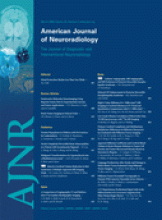Abstract
BACKGROUND AND PURPOSE: Endovascular coil embolization is used increasingly to treat cerebral aneurysms. The purpose of our study was to quantify the incidence of CT-detectable abnormalities after aneurysm coiling and map the radiographic and clinical progression.
MATERIALS AND METHODS: We reviewed the radiographic and clinical sequelae of 30 consecutive patients with aneurysms who underwent endosaccular coiling followed by head CT scans. Patients with CT abnormalities received follow-up scans at 4 to 6 hours and 20 to 25 hours. Contrast enhancement was defined as CT hyperdensities with progressive resolution over 25 hours and a Hounsfield unit (HU) of less than 70. The incidence of CT abnormalities was recorded and correlated with amount of contrast used, use of antiplatelet agents, procedure time, and clinical sequelae.
RESULTS: Seven patients (23%) had new hyperdensities on CT scan. Four showed gyral hyperattenuation; 1 showed basal ganglia hyperattenuation, and 2 showed a combination of these patterns. All were asymptomatic and were consistent with contrast enhancement, with complete resolution in 5 of 7 and partial resolution in 2 of 7 by 20 to 25 hours. Antithrombotic or antiplatelet medication was continued in all cases. The amount of contrast used (P = .014) and the use of antiplatelet medication (P = .029) were statistically correlated with the presence of hyperattenuation after aneurysm coiling, whereas the length of the procedure was not (P = .162).
CONCLUSION: Contrast enhancement, unlike contrast extravasation, is a fairly common and clinically benign finding after aneurysm coiling. The enhancement resolves by 25 hours in most cases, regardless of the continuation of antithrombotic or antiplatelet therapy.
- Copyright © American Society of Neuroradiology












